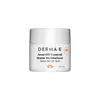What's inside
What's inside
 Key Ingredients
Key Ingredients

 Benefits
Benefits

 Concerns
Concerns

No concerns
 Ingredients Side-by-side
Ingredients Side-by-side

Salicylic Acid 0.53%
MaskingWater
Skin ConditioningStearic Acid
CleansingCaprylic/Capric Triglyceride
MaskingCetyl Alcohol
EmollientGlyceryl Stearate Citrate
EmollientMelaleuca Alternifolia Leaf Oil
AntioxidantGlycerin
HumectantPolysorbate 60
EmulsifyingSalix Alba Bark Extract
AstringentAniba Rosodora Wood Oil
AstringentSimmondsia Chinensis Seed Oil
EmollientChamomilla Recutita Flower Extract
MaskingAloe Barbadensis Extract
Skin ConditioningAllantoin
Skin ConditioningPanthenol
Skin ConditioningXanthan Gum
EmulsifyingPolysorbate 20
EmulsifyingGlyceryl Stearate
EmollientCetearyl Glucoside
EmulsifyingPotassium Sorbate
PreservativePhenoxyethanol
PreservativeEthylhexylglycerin
Skin ConditioningLavandula Angustifolia Oil
MaskingSalicylic Acid 0.53%, Water, Stearic Acid, Caprylic/Capric Triglyceride, Cetyl Alcohol, Glyceryl Stearate Citrate, Melaleuca Alternifolia Leaf Oil, Glycerin, Polysorbate 60, Salix Alba Bark Extract, Aniba Rosodora Wood Oil, Simmondsia Chinensis Seed Oil, Chamomilla Recutita Flower Extract, Aloe Barbadensis Extract, Allantoin, Panthenol, Xanthan Gum, Polysorbate 20, Glyceryl Stearate, Cetearyl Glucoside, Potassium Sorbate, Phenoxyethanol, Ethylhexylglycerin, Lavandula Angustifolia Oil
Water
Skin ConditioningDimethicone
EmollientPropanediol
SolventButylene Glycol
HumectantNiacinamide
SmoothingNylon-12
Acrylates Crosspolymer
AbsorbentSodium Hyaluronate
HumectantEnantia Chlorantha Bark Extract
Skin ConditioningAvena Sativa Kernel Extract
AbrasiveCamellia Sinensis Leaf Extract
AntimicrobialChrysanthemum Parthenium Extract
Skin ConditioningGlycerin
HumectantOleanolic Acid
Skin ConditioningSorbitan Isostearate
EmulsifyingCaprylyl Glycol
EmollientGlyceryl Stearate Citrate
EmollientHydrogenated Polydecene
Emollient2-Hydroxyethyl Acrylate
1,2-Hexanediol
Skin ConditioningLecithin
EmollientPolysilicone-11
Polysorbate 60
EmulsifyingSodium Caprylate
EmulsifyingSodium Acrylates Copolymer
Laureth-8
EmulsifyingCitric Acid
BufferingPhenoxyethanol
PreservativePotassium Sorbate
PreservativeSodium Benzoate
MaskingWater, Dimethicone, Propanediol, Butylene Glycol, Niacinamide, Nylon-12, Acrylates Crosspolymer, Sodium Hyaluronate, Enantia Chlorantha Bark Extract, Avena Sativa Kernel Extract, Camellia Sinensis Leaf Extract, Chrysanthemum Parthenium Extract, Glycerin, Oleanolic Acid, Sorbitan Isostearate, Caprylyl Glycol, Glyceryl Stearate Citrate, Hydrogenated Polydecene, 2-Hydroxyethyl Acrylate, 1,2-Hexanediol, Lecithin, Polysilicone-11, Polysorbate 60, Sodium Caprylate, Sodium Acrylates Copolymer, Laureth-8, Citric Acid, Phenoxyethanol, Potassium Sorbate, Sodium Benzoate
 Reviews
Reviews

Ingredients Explained
These ingredients are found in both products.
Ingredients higher up in an ingredient list are typically present in a larger amount.
Glycerin is already naturally found in your skin. It helps moisturize and protect your skin.
A study from 2016 found glycerin to be more effective as a humectant than AHAs and hyaluronic acid.
As a humectant, it helps the skin stay hydrated by pulling moisture to your skin. The low molecular weight of glycerin allows it to pull moisture into the deeper layers of your skin.
Hydrated skin improves your skin barrier; Your skin barrier helps protect against irritants and bacteria.
Glycerin has also been found to have antimicrobial and antiviral properties. Due to these properties, glycerin is often used in wound and burn treatments.
In cosmetics, glycerin is usually derived from plants such as soybean or palm. However, it can also be sourced from animals, such as tallow or animal fat.
This ingredient is organic, colorless, odorless, and non-toxic.
Glycerin is the name for this ingredient in American English. British English uses Glycerol/Glycerine.
Learn more about GlycerinGlyceryl Stearate Citrate is a citric acid ester of glyceryl stearate.
It is an emulsifier, emollient, and a surfactant.
Emulsifiers help stabilize a product. It does this by preventing certain ingredients from separating. Common ingredients include oils and water, which do not mix naturally. Emulsifiers have properties that help keep ingredients such as these together.
Emollients help soothe and soften the skin. They do this by creating a protective film on your skin. This barrier helps trap moisture and keeps your skin hydrated. Emollients may be effective at treating dry or itchy skin.
Surfactants help gather oils, dirt, and other pollutants from the skin. This helps them to be easily rinsed away.
Learn more about Glyceryl Stearate CitratePhenoxyethanol is a preservative that has germicide, antimicrobial, and aromatic properties. Studies show that phenoxyethanol can prevent microbial growth. By itself, it has a scent that is similar to that of a rose.
It's often used in formulations along with Caprylyl Glycol to preserve the shelf life of products.
Polysorbate 60 is used to help stabilize products. It is a surfactant and emulsifier. These properties help keep ingredients together in a product. Surfactants help reduce surface tension between ingredients with different states, such as liquids and solids. Emulsifiers help prevent oils and waters from separating.
Polysorbate 60 is sorbitol-based and created from the ethoxylation of sorbitan. Ethoxylation is a chemical reaction used to add ethylene oxide. Sorbitan is a the dehydrated version of sorbitol, a sugar found in fruits.
In this case, the 60 comes from reacting 60 units of ethylene oxide with sorbitan.
Polysorbates are commonly used in medicine and foods.
Learn more about Polysorbate 60Potassium Sorbate is a preservative used to prevent yeast and mold in products. It is commonly found in both cosmetic and food products.
This ingredient comes from potassium salt derived from sorbic acid. Sorbic acid is a natural antibiotic and effective against fungus.
Both potassium sorbate and sorbic acid can be found in baked goods, cheeses, dried meats, dried fruit, ice cream, pickles, wine, yogurt, and more.
You'll often find this ingredient used with other preservatives.
Learn more about Potassium SorbateWater. It's the most common cosmetic ingredient of all. You'll usually see it at the top of ingredient lists, meaning that it makes up the largest part of the product.
So why is it so popular? Water most often acts as a solvent - this means that it helps dissolve other ingredients into the formulation.
You'll also recognize water as that liquid we all need to stay alive. If you see this, drink a glass of water. Stay hydrated!
Learn more about Water